Organisational Behaviour Report: Impact of Power, Culture & Politics
VerifiedAdded on 2020/12/09
|24
|7670
|261
Report
AI Summary
This report examines organisational behaviour, focusing on the impact of power, culture, and politics on individual and team performance within A David & Co. Ltd. It explores the influence of power dynamics, various cultural models, and the role of leadership in shaping employee behaviour. The report evaluates content and process theories of motivation, providing insights into how to enhance employee engagement and productivity. Furthermore, it investigates the characteristics of effective and ineffective teams, offering strategies for fostering positive team dynamics. The report also delves into the concepts and philosophies of organisational behaviour in the context of the selected business, providing a comprehensive understanding of the factors that contribute to organisational success. The report concludes by highlighting the significance of aligning organisational practices with employee needs to achieve business objectives.
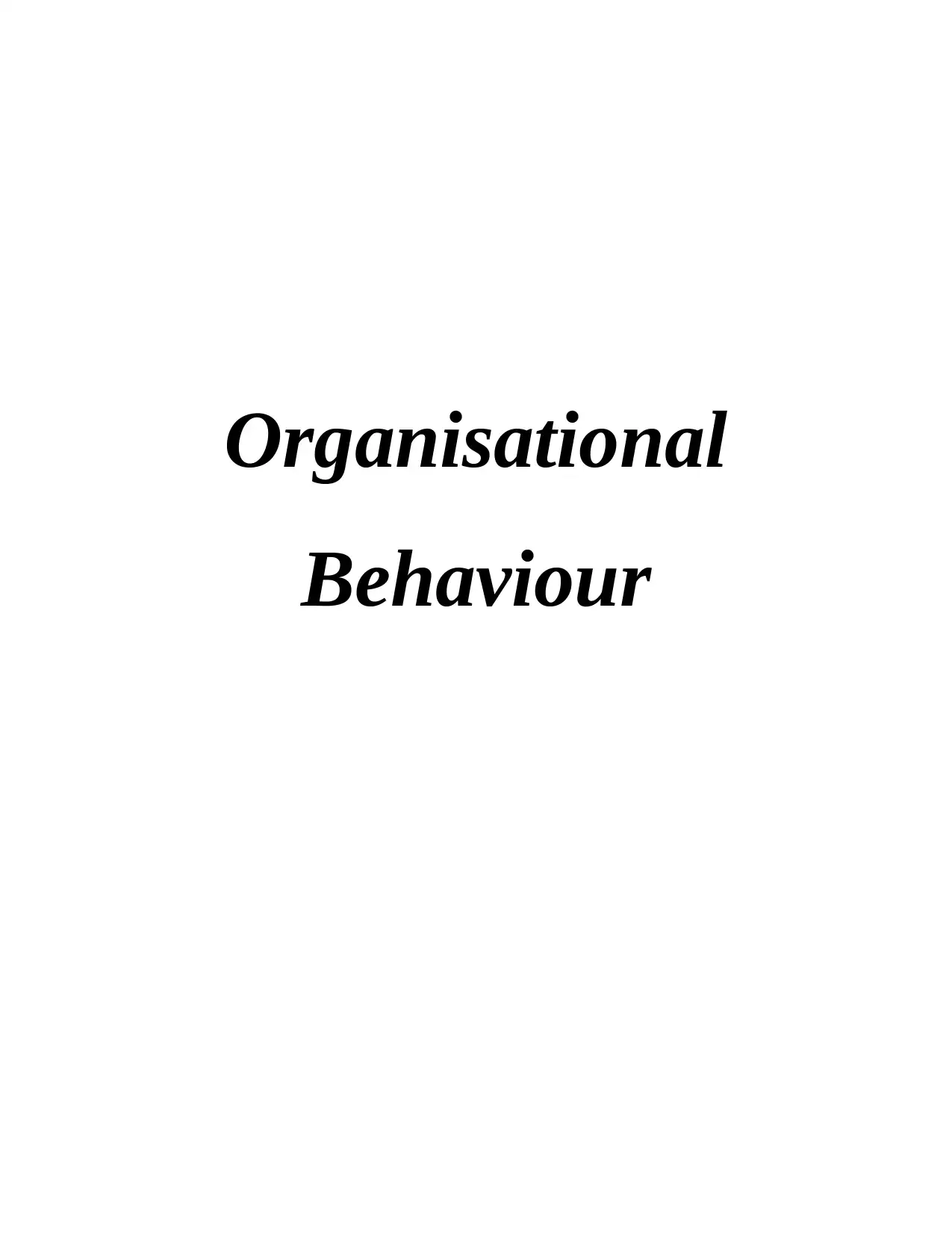
Organisational
Behaviour
Behaviour
Paraphrase This Document
Need a fresh take? Get an instant paraphrase of this document with our AI Paraphraser
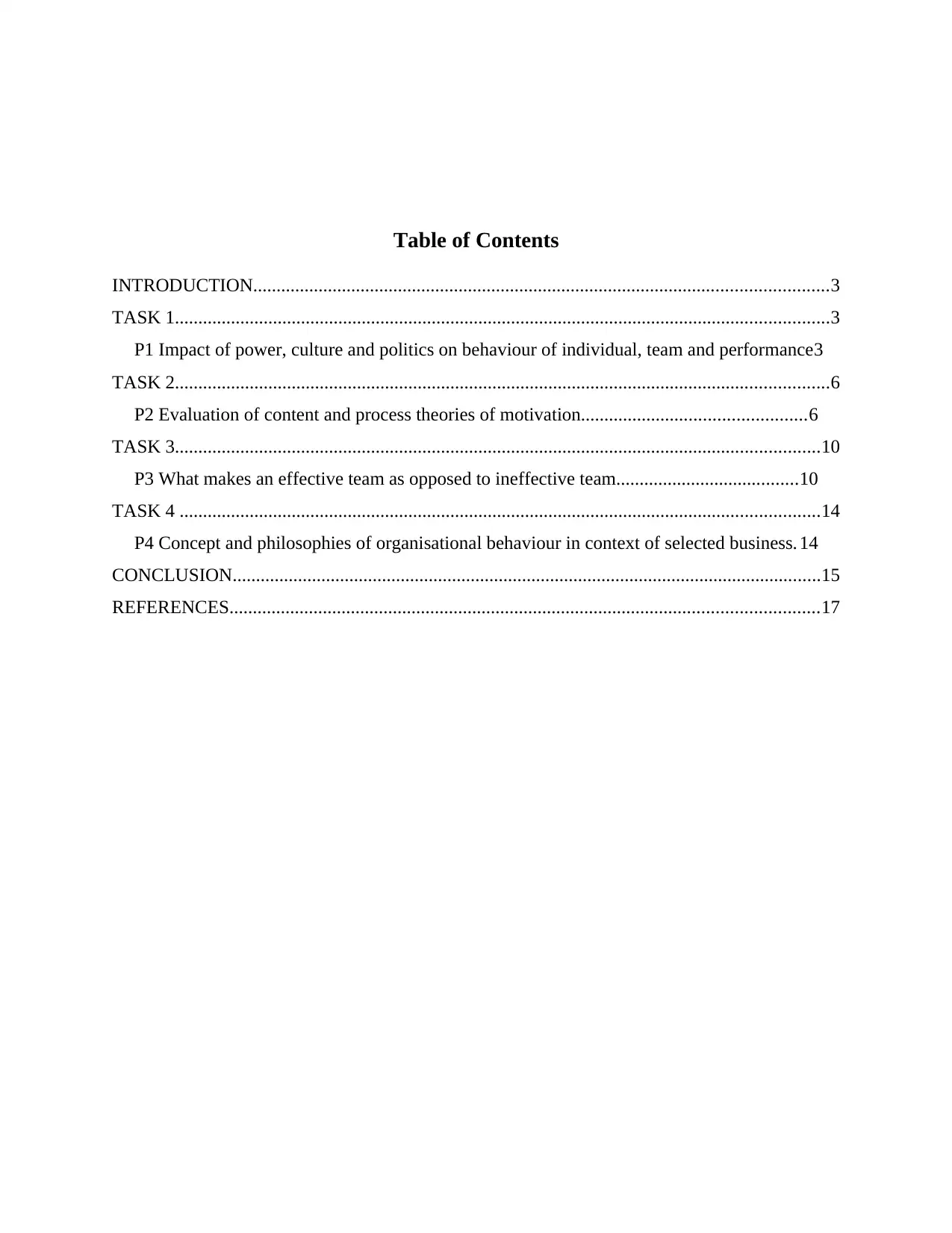
Table of Contents
INTRODUCTION...........................................................................................................................3
TASK 1............................................................................................................................................3
P1 Impact of power, culture and politics on behaviour of individual, team and performance3
TASK 2............................................................................................................................................6
P2 Evaluation of content and process theories of motivation................................................6
TASK 3..........................................................................................................................................10
P3 What makes an effective team as opposed to ineffective team.......................................10
TASK 4 .........................................................................................................................................14
P4 Concept and philosophies of organisational behaviour in context of selected business. 14
CONCLUSION..............................................................................................................................15
REFERENCES..............................................................................................................................17
INTRODUCTION...........................................................................................................................3
TASK 1............................................................................................................................................3
P1 Impact of power, culture and politics on behaviour of individual, team and performance3
TASK 2............................................................................................................................................6
P2 Evaluation of content and process theories of motivation................................................6
TASK 3..........................................................................................................................................10
P3 What makes an effective team as opposed to ineffective team.......................................10
TASK 4 .........................................................................................................................................14
P4 Concept and philosophies of organisational behaviour in context of selected business. 14
CONCLUSION..............................................................................................................................15
REFERENCES..............................................................................................................................17
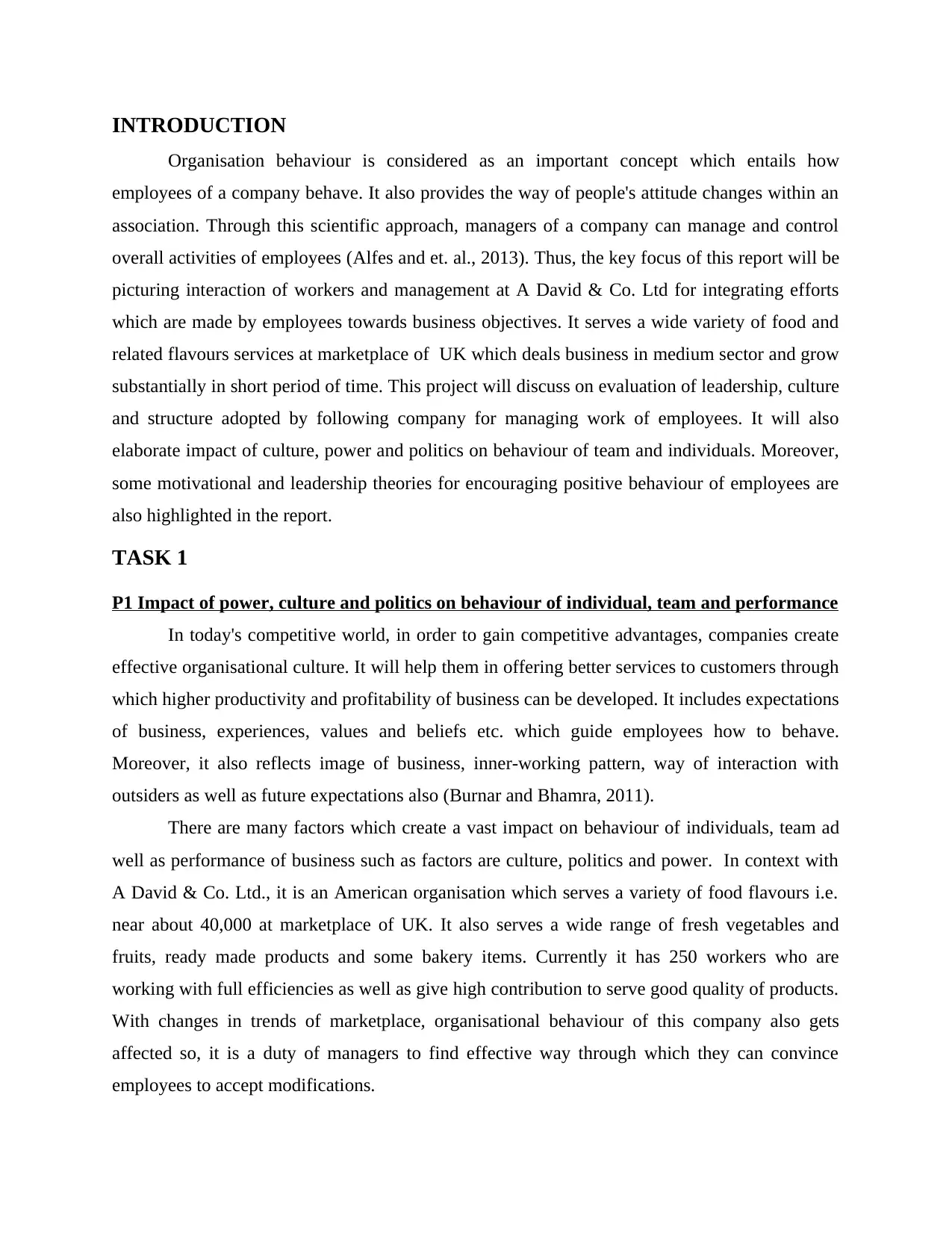
INTRODUCTION
Organisation behaviour is considered as an important concept which entails how
employees of a company behave. It also provides the way of people's attitude changes within an
association. Through this scientific approach, managers of a company can manage and control
overall activities of employees (Alfes and et. al., 2013). Thus, the key focus of this report will be
picturing interaction of workers and management at A David & Co. Ltd for integrating efforts
which are made by employees towards business objectives. It serves a wide variety of food and
related flavours services at marketplace of UK which deals business in medium sector and grow
substantially in short period of time. This project will discuss on evaluation of leadership, culture
and structure adopted by following company for managing work of employees. It will also
elaborate impact of culture, power and politics on behaviour of team and individuals. Moreover,
some motivational and leadership theories for encouraging positive behaviour of employees are
also highlighted in the report.
TASK 1
P1 Impact of power, culture and politics on behaviour of individual, team and performance
In today's competitive world, in order to gain competitive advantages, companies create
effective organisational culture. It will help them in offering better services to customers through
which higher productivity and profitability of business can be developed. It includes expectations
of business, experiences, values and beliefs etc. which guide employees how to behave.
Moreover, it also reflects image of business, inner-working pattern, way of interaction with
outsiders as well as future expectations also (Burnar and Bhamra, 2011).
There are many factors which create a vast impact on behaviour of individuals, team ad
well as performance of business such as factors are culture, politics and power. In context with
A David & Co. Ltd., it is an American organisation which serves a variety of food flavours i.e.
near about 40,000 at marketplace of UK. It also serves a wide range of fresh vegetables and
fruits, ready made products and some bakery items. Currently it has 250 workers who are
working with full efficiencies as well as give high contribution to serve good quality of products.
With changes in trends of marketplace, organisational behaviour of this company also gets
affected so, it is a duty of managers to find effective way through which they can convince
employees to accept modifications.
Organisation behaviour is considered as an important concept which entails how
employees of a company behave. It also provides the way of people's attitude changes within an
association. Through this scientific approach, managers of a company can manage and control
overall activities of employees (Alfes and et. al., 2013). Thus, the key focus of this report will be
picturing interaction of workers and management at A David & Co. Ltd for integrating efforts
which are made by employees towards business objectives. It serves a wide variety of food and
related flavours services at marketplace of UK which deals business in medium sector and grow
substantially in short period of time. This project will discuss on evaluation of leadership, culture
and structure adopted by following company for managing work of employees. It will also
elaborate impact of culture, power and politics on behaviour of team and individuals. Moreover,
some motivational and leadership theories for encouraging positive behaviour of employees are
also highlighted in the report.
TASK 1
P1 Impact of power, culture and politics on behaviour of individual, team and performance
In today's competitive world, in order to gain competitive advantages, companies create
effective organisational culture. It will help them in offering better services to customers through
which higher productivity and profitability of business can be developed. It includes expectations
of business, experiences, values and beliefs etc. which guide employees how to behave.
Moreover, it also reflects image of business, inner-working pattern, way of interaction with
outsiders as well as future expectations also (Burnar and Bhamra, 2011).
There are many factors which create a vast impact on behaviour of individuals, team ad
well as performance of business such as factors are culture, politics and power. In context with
A David & Co. Ltd., it is an American organisation which serves a variety of food flavours i.e.
near about 40,000 at marketplace of UK. It also serves a wide range of fresh vegetables and
fruits, ready made products and some bakery items. Currently it has 250 workers who are
working with full efficiencies as well as give high contribution to serve good quality of products.
With changes in trends of marketplace, organisational behaviour of this company also gets
affected so, it is a duty of managers to find effective way through which they can convince
employees to accept modifications.
⊘ This is a preview!⊘
Do you want full access?
Subscribe today to unlock all pages.

Trusted by 1+ million students worldwide
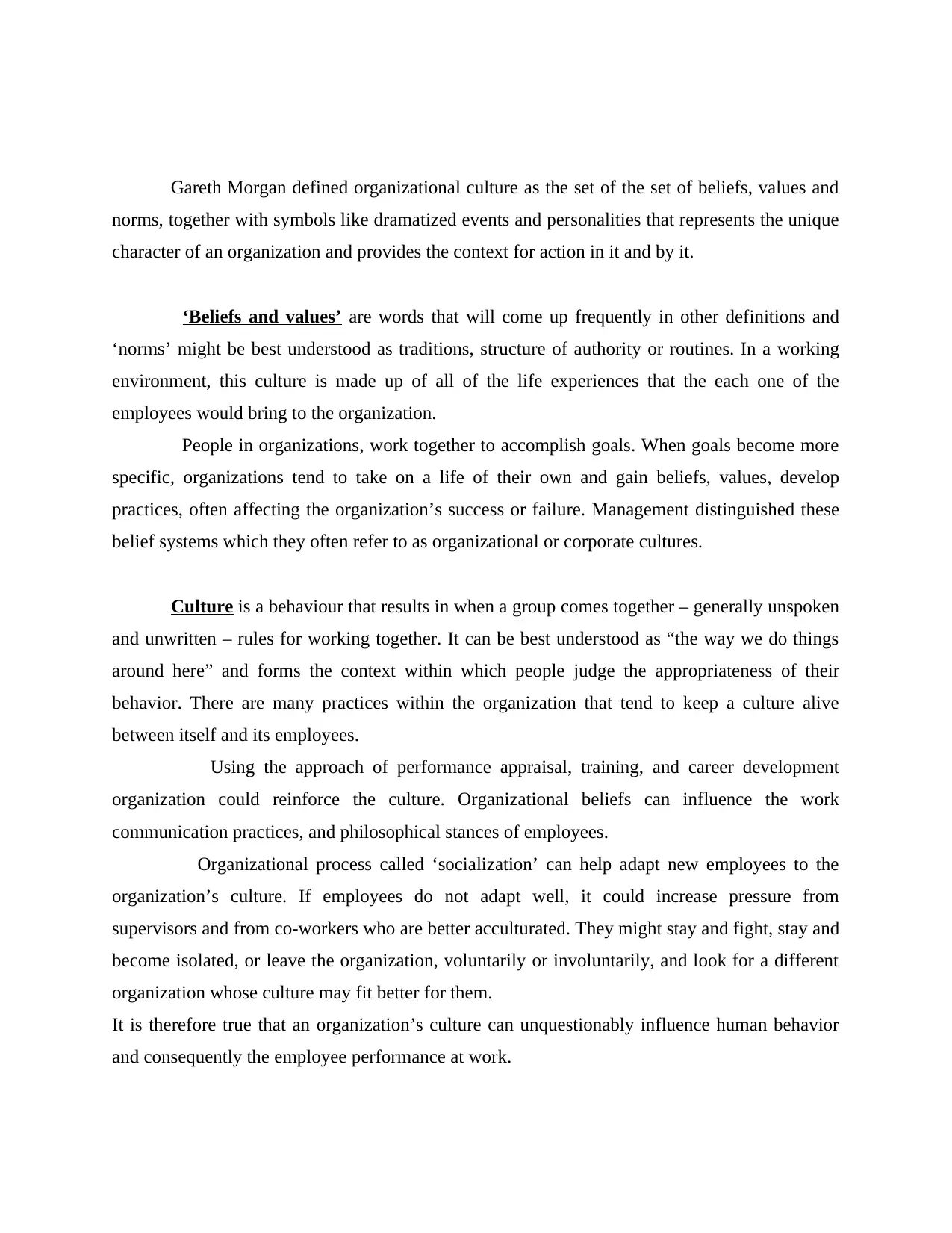
Gareth Morgan defined organizational culture as the set of the set of beliefs, values and
norms, together with symbols like dramatized events and personalities that represents the unique
character of an organization and provides the context for action in it and by it.
‘Beliefs and values’ are words that will come up frequently in other definitions and
‘norms’ might be best understood as traditions, structure of authority or routines. In a working
environment, this culture is made up of all of the life experiences that the each one of the
employees would bring to the organization.
People in organizations, work together to accomplish goals. When goals become more
specific, organizations tend to take on a life of their own and gain beliefs, values, develop
practices, often affecting the organization’s success or failure. Management distinguished these
belief systems which they often refer to as organizational or corporate cultures.
Culture is a behaviour that results in when a group comes together – generally unspoken
and unwritten – rules for working together. It can be best understood as “the way we do things
around here” and forms the context within which people judge the appropriateness of their
behavior. There are many practices within the organization that tend to keep a culture alive
between itself and its employees.
Using the approach of performance appraisal, training, and career development
organization could reinforce the culture. Organizational beliefs can influence the work
communication practices, and philosophical stances of employees.
Organizational process called ‘socialization’ can help adapt new employees to the
organization’s culture. If employees do not adapt well, it could increase pressure from
supervisors and from co-workers who are better acculturated. They might stay and fight, stay and
become isolated, or leave the organization, voluntarily or involuntarily, and look for a different
organization whose culture may fit better for them.
It is therefore true that an organization’s culture can unquestionably influence human behavior
and consequently the employee performance at work.
norms, together with symbols like dramatized events and personalities that represents the unique
character of an organization and provides the context for action in it and by it.
‘Beliefs and values’ are words that will come up frequently in other definitions and
‘norms’ might be best understood as traditions, structure of authority or routines. In a working
environment, this culture is made up of all of the life experiences that the each one of the
employees would bring to the organization.
People in organizations, work together to accomplish goals. When goals become more
specific, organizations tend to take on a life of their own and gain beliefs, values, develop
practices, often affecting the organization’s success or failure. Management distinguished these
belief systems which they often refer to as organizational or corporate cultures.
Culture is a behaviour that results in when a group comes together – generally unspoken
and unwritten – rules for working together. It can be best understood as “the way we do things
around here” and forms the context within which people judge the appropriateness of their
behavior. There are many practices within the organization that tend to keep a culture alive
between itself and its employees.
Using the approach of performance appraisal, training, and career development
organization could reinforce the culture. Organizational beliefs can influence the work
communication practices, and philosophical stances of employees.
Organizational process called ‘socialization’ can help adapt new employees to the
organization’s culture. If employees do not adapt well, it could increase pressure from
supervisors and from co-workers who are better acculturated. They might stay and fight, stay and
become isolated, or leave the organization, voluntarily or involuntarily, and look for a different
organization whose culture may fit better for them.
It is therefore true that an organization’s culture can unquestionably influence human behavior
and consequently the employee performance at work.
Paraphrase This Document
Need a fresh take? Get an instant paraphrase of this document with our AI Paraphraser
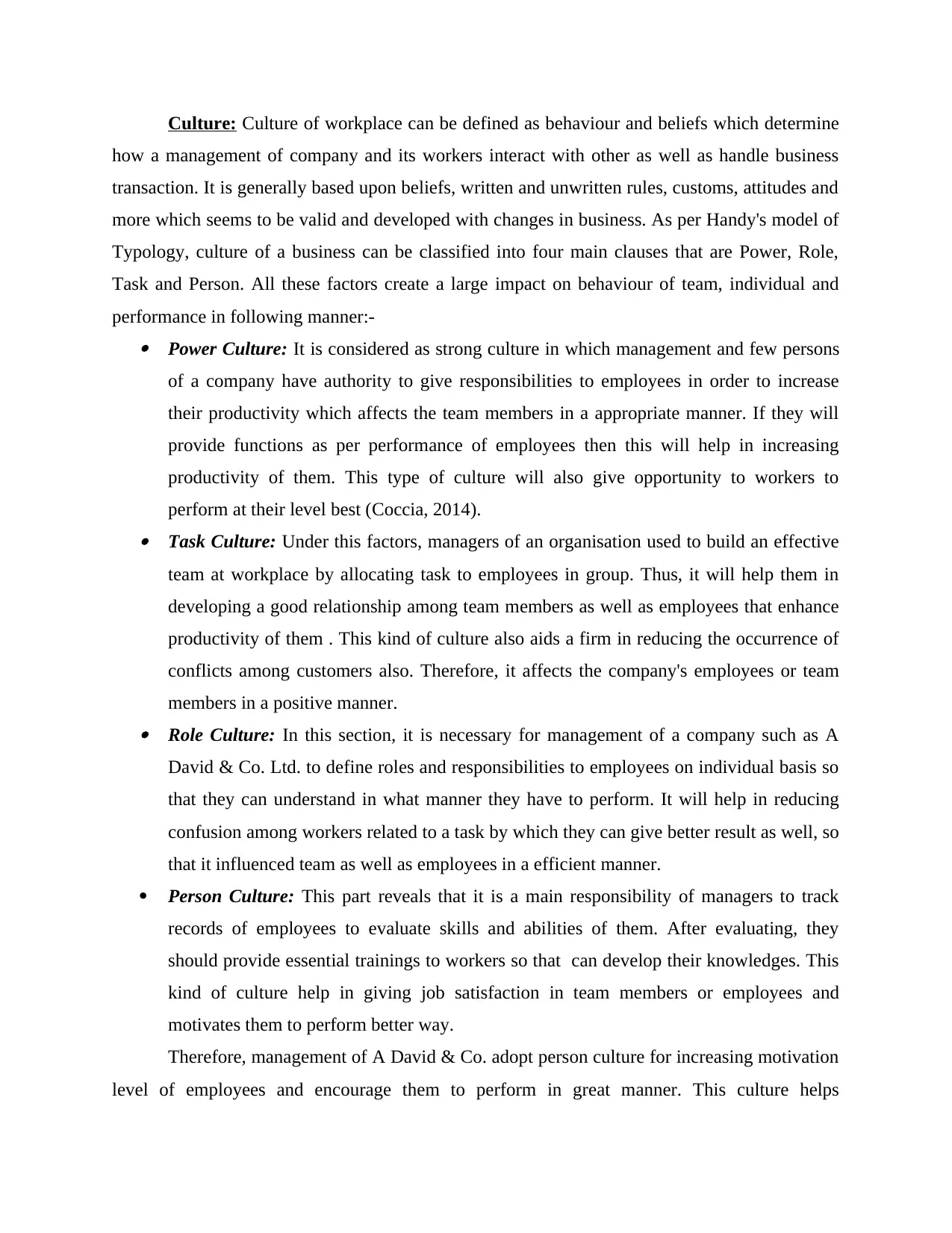
Culture: Culture of workplace can be defined as behaviour and beliefs which determine
how a management of company and its workers interact with other as well as handle business
transaction. It is generally based upon beliefs, written and unwritten rules, customs, attitudes and
more which seems to be valid and developed with changes in business. As per Handy's model of
Typology, culture of a business can be classified into four main clauses that are Power, Role,
Task and Person. All these factors create a large impact on behaviour of team, individual and
performance in following manner:- Power Culture: It is considered as strong culture in which management and few persons
of a company have authority to give responsibilities to employees in order to increase
their productivity which affects the team members in a appropriate manner. If they will
provide functions as per performance of employees then this will help in increasing
productivity of them. This type of culture will also give opportunity to workers to
perform at their level best (Coccia, 2014). Task Culture: Under this factors, managers of an organisation used to build an effective
team at workplace by allocating task to employees in group. Thus, it will help them in
developing a good relationship among team members as well as employees that enhance
productivity of them . This kind of culture also aids a firm in reducing the occurrence of
conflicts among customers also. Therefore, it affects the company's employees or team
members in a positive manner. Role Culture: In this section, it is necessary for management of a company such as A
David & Co. Ltd. to define roles and responsibilities to employees on individual basis so
that they can understand in what manner they have to perform. It will help in reducing
confusion among workers related to a task by which they can give better result as well, so
that it influenced team as well as employees in a efficient manner.
Person Culture: This part reveals that it is a main responsibility of managers to track
records of employees to evaluate skills and abilities of them. After evaluating, they
should provide essential trainings to workers so that can develop their knowledges. This
kind of culture help in giving job satisfaction in team members or employees and
motivates them to perform better way.
Therefore, management of A David & Co. adopt person culture for increasing motivation
level of employees and encourage them to perform in great manner. This culture helps
how a management of company and its workers interact with other as well as handle business
transaction. It is generally based upon beliefs, written and unwritten rules, customs, attitudes and
more which seems to be valid and developed with changes in business. As per Handy's model of
Typology, culture of a business can be classified into four main clauses that are Power, Role,
Task and Person. All these factors create a large impact on behaviour of team, individual and
performance in following manner:- Power Culture: It is considered as strong culture in which management and few persons
of a company have authority to give responsibilities to employees in order to increase
their productivity which affects the team members in a appropriate manner. If they will
provide functions as per performance of employees then this will help in increasing
productivity of them. This type of culture will also give opportunity to workers to
perform at their level best (Coccia, 2014). Task Culture: Under this factors, managers of an organisation used to build an effective
team at workplace by allocating task to employees in group. Thus, it will help them in
developing a good relationship among team members as well as employees that enhance
productivity of them . This kind of culture also aids a firm in reducing the occurrence of
conflicts among customers also. Therefore, it affects the company's employees or team
members in a positive manner. Role Culture: In this section, it is necessary for management of a company such as A
David & Co. Ltd. to define roles and responsibilities to employees on individual basis so
that they can understand in what manner they have to perform. It will help in reducing
confusion among workers related to a task by which they can give better result as well, so
that it influenced team as well as employees in a efficient manner.
Person Culture: This part reveals that it is a main responsibility of managers to track
records of employees to evaluate skills and abilities of them. After evaluating, they
should provide essential trainings to workers so that can develop their knowledges. This
kind of culture help in giving job satisfaction in team members or employees and
motivates them to perform better way.
Therefore, management of A David & Co. adopt person culture for increasing motivation
level of employees and encourage them to perform in great manner. This culture helps
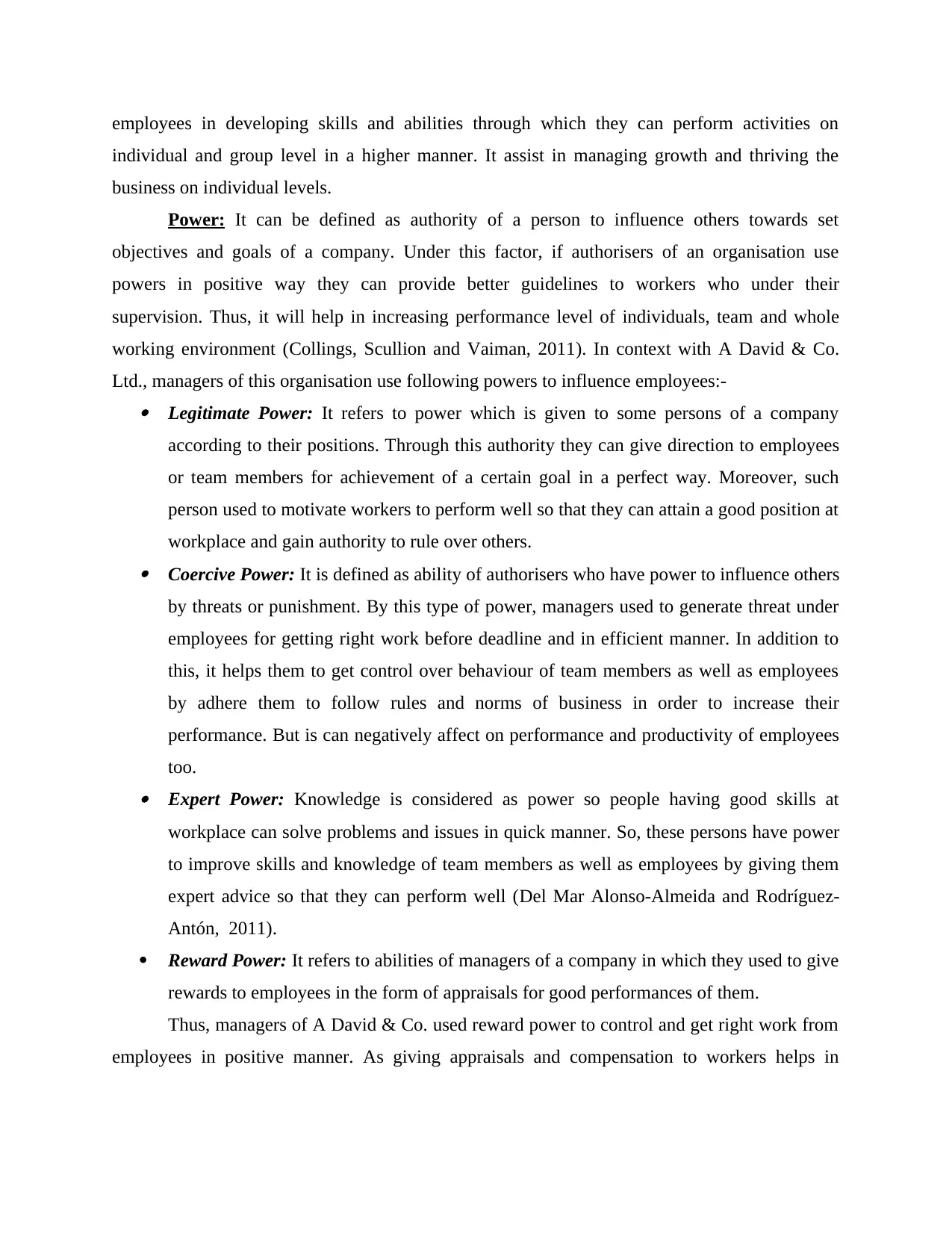
employees in developing skills and abilities through which they can perform activities on
individual and group level in a higher manner. It assist in managing growth and thriving the
business on individual levels.
Power: It can be defined as authority of a person to influence others towards set
objectives and goals of a company. Under this factor, if authorisers of an organisation use
powers in positive way they can provide better guidelines to workers who under their
supervision. Thus, it will help in increasing performance level of individuals, team and whole
working environment (Collings, Scullion and Vaiman, 2011). In context with A David & Co.
Ltd., managers of this organisation use following powers to influence employees:- Legitimate Power: It refers to power which is given to some persons of a company
according to their positions. Through this authority they can give direction to employees
or team members for achievement of a certain goal in a perfect way. Moreover, such
person used to motivate workers to perform well so that they can attain a good position at
workplace and gain authority to rule over others. Coercive Power: It is defined as ability of authorisers who have power to influence others
by threats or punishment. By this type of power, managers used to generate threat under
employees for getting right work before deadline and in efficient manner. In addition to
this, it helps them to get control over behaviour of team members as well as employees
by adhere them to follow rules and norms of business in order to increase their
performance. But is can negatively affect on performance and productivity of employees
too. Expert Power: Knowledge is considered as power so people having good skills at
workplace can solve problems and issues in quick manner. So, these persons have power
to improve skills and knowledge of team members as well as employees by giving them
expert advice so that they can perform well (Del Mar Alonso-Almeida and Rodríguez-
Antón, 2011).
Reward Power: It refers to abilities of managers of a company in which they used to give
rewards to employees in the form of appraisals for good performances of them.
Thus, managers of A David & Co. used reward power to control and get right work from
employees in positive manner. As giving appraisals and compensation to workers helps in
individual and group level in a higher manner. It assist in managing growth and thriving the
business on individual levels.
Power: It can be defined as authority of a person to influence others towards set
objectives and goals of a company. Under this factor, if authorisers of an organisation use
powers in positive way they can provide better guidelines to workers who under their
supervision. Thus, it will help in increasing performance level of individuals, team and whole
working environment (Collings, Scullion and Vaiman, 2011). In context with A David & Co.
Ltd., managers of this organisation use following powers to influence employees:- Legitimate Power: It refers to power which is given to some persons of a company
according to their positions. Through this authority they can give direction to employees
or team members for achievement of a certain goal in a perfect way. Moreover, such
person used to motivate workers to perform well so that they can attain a good position at
workplace and gain authority to rule over others. Coercive Power: It is defined as ability of authorisers who have power to influence others
by threats or punishment. By this type of power, managers used to generate threat under
employees for getting right work before deadline and in efficient manner. In addition to
this, it helps them to get control over behaviour of team members as well as employees
by adhere them to follow rules and norms of business in order to increase their
performance. But is can negatively affect on performance and productivity of employees
too. Expert Power: Knowledge is considered as power so people having good skills at
workplace can solve problems and issues in quick manner. So, these persons have power
to improve skills and knowledge of team members as well as employees by giving them
expert advice so that they can perform well (Del Mar Alonso-Almeida and Rodríguez-
Antón, 2011).
Reward Power: It refers to abilities of managers of a company in which they used to give
rewards to employees in the form of appraisals for good performances of them.
Thus, managers of A David & Co. used reward power to control and get right work from
employees in positive manner. As giving appraisals and compensation to workers helps in
⊘ This is a preview!⊘
Do you want full access?
Subscribe today to unlock all pages.

Trusted by 1+ million students worldwide
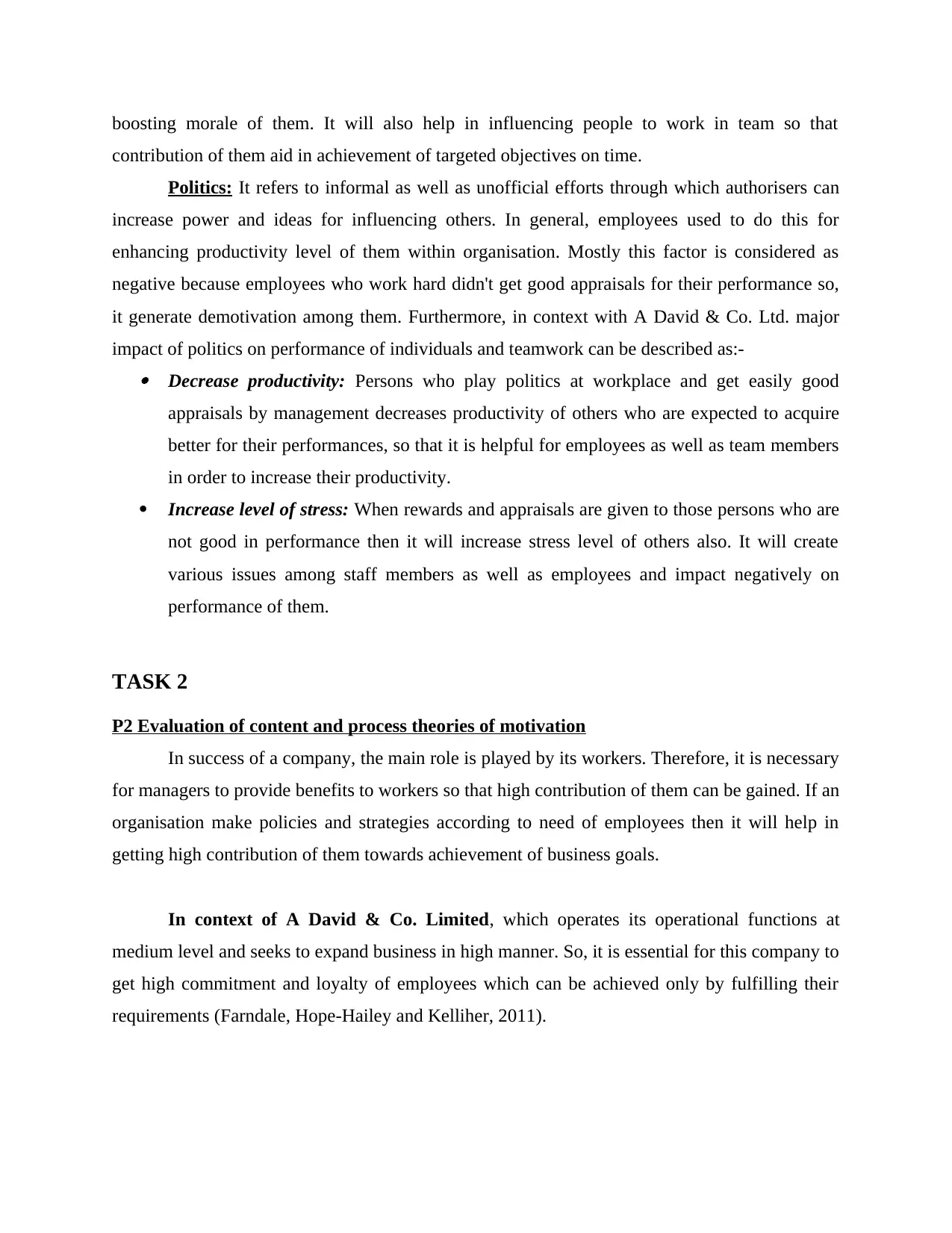
boosting morale of them. It will also help in influencing people to work in team so that
contribution of them aid in achievement of targeted objectives on time.
Politics: It refers to informal as well as unofficial efforts through which authorisers can
increase power and ideas for influencing others. In general, employees used to do this for
enhancing productivity level of them within organisation. Mostly this factor is considered as
negative because employees who work hard didn't get good appraisals for their performance so,
it generate demotivation among them. Furthermore, in context with A David & Co. Ltd. major
impact of politics on performance of individuals and teamwork can be described as:- Decrease productivity: Persons who play politics at workplace and get easily good
appraisals by management decreases productivity of others who are expected to acquire
better for their performances, so that it is helpful for employees as well as team members
in order to increase their productivity.
Increase level of stress: When rewards and appraisals are given to those persons who are
not good in performance then it will increase stress level of others also. It will create
various issues among staff members as well as employees and impact negatively on
performance of them.
TASK 2
P2 Evaluation of content and process theories of motivation
In success of a company, the main role is played by its workers. Therefore, it is necessary
for managers to provide benefits to workers so that high contribution of them can be gained. If an
organisation make policies and strategies according to need of employees then it will help in
getting high contribution of them towards achievement of business goals.
In context of A David & Co. Limited, which operates its operational functions at
medium level and seeks to expand business in high manner. So, it is essential for this company to
get high commitment and loyalty of employees which can be achieved only by fulfilling their
requirements (Farndale, Hope-Hailey and Kelliher, 2011).
contribution of them aid in achievement of targeted objectives on time.
Politics: It refers to informal as well as unofficial efforts through which authorisers can
increase power and ideas for influencing others. In general, employees used to do this for
enhancing productivity level of them within organisation. Mostly this factor is considered as
negative because employees who work hard didn't get good appraisals for their performance so,
it generate demotivation among them. Furthermore, in context with A David & Co. Ltd. major
impact of politics on performance of individuals and teamwork can be described as:- Decrease productivity: Persons who play politics at workplace and get easily good
appraisals by management decreases productivity of others who are expected to acquire
better for their performances, so that it is helpful for employees as well as team members
in order to increase their productivity.
Increase level of stress: When rewards and appraisals are given to those persons who are
not good in performance then it will increase stress level of others also. It will create
various issues among staff members as well as employees and impact negatively on
performance of them.
TASK 2
P2 Evaluation of content and process theories of motivation
In success of a company, the main role is played by its workers. Therefore, it is necessary
for managers to provide benefits to workers so that high contribution of them can be gained. If an
organisation make policies and strategies according to need of employees then it will help in
getting high contribution of them towards achievement of business goals.
In context of A David & Co. Limited, which operates its operational functions at
medium level and seeks to expand business in high manner. So, it is essential for this company to
get high commitment and loyalty of employees which can be achieved only by fulfilling their
requirements (Farndale, Hope-Hailey and Kelliher, 2011).
Paraphrase This Document
Need a fresh take? Get an instant paraphrase of this document with our AI Paraphraser
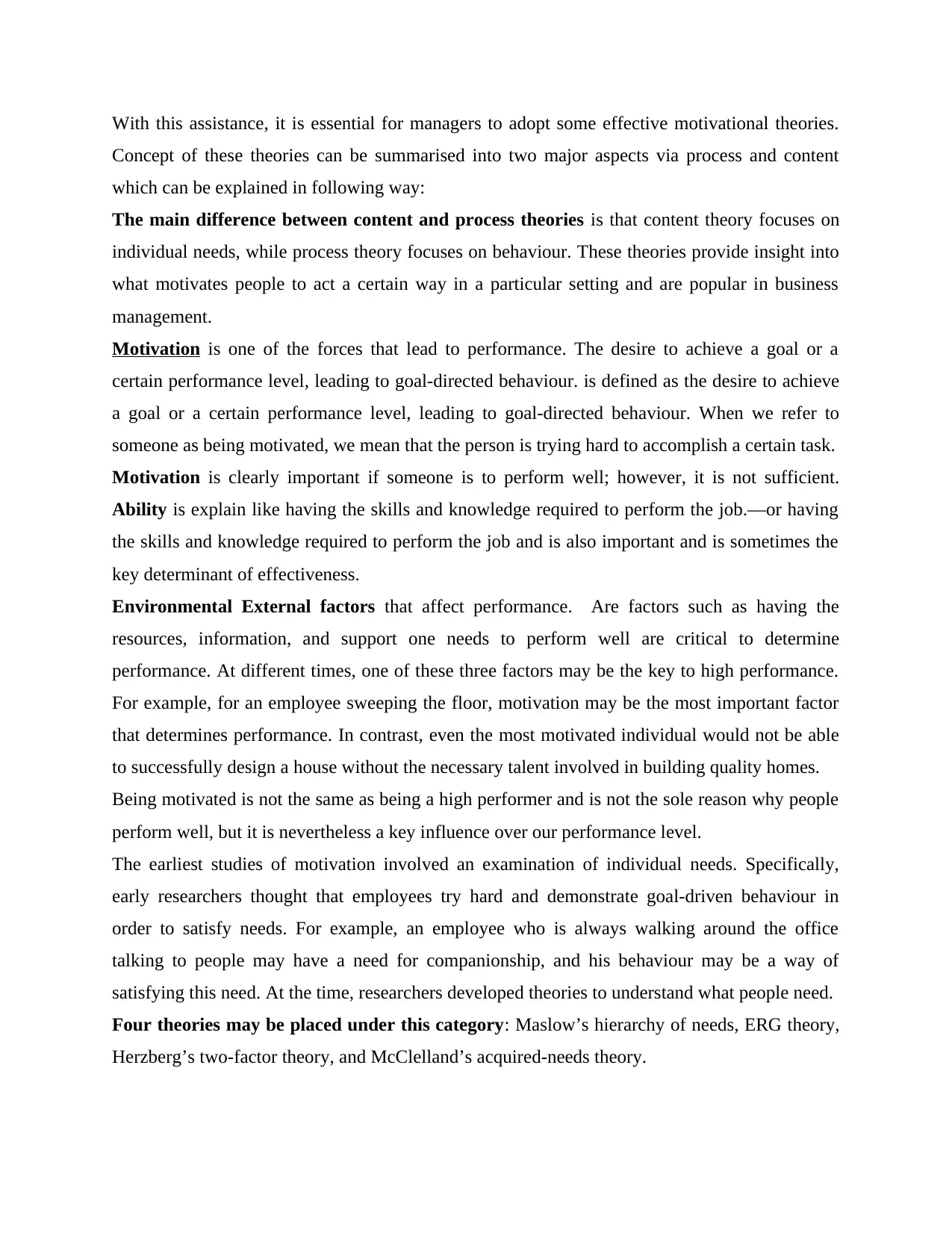
With this assistance, it is essential for managers to adopt some effective motivational theories.
Concept of these theories can be summarised into two major aspects via process and content
which can be explained in following way:
The main difference between content and process theories is that content theory focuses on
individual needs, while process theory focuses on behaviour. These theories provide insight into
what motivates people to act a certain way in a particular setting and are popular in business
management.
Motivation is one of the forces that lead to performance. The desire to achieve a goal or a
certain performance level, leading to goal-directed behaviour. is defined as the desire to achieve
a goal or a certain performance level, leading to goal-directed behaviour. When we refer to
someone as being motivated, we mean that the person is trying hard to accomplish a certain task.
Motivation is clearly important if someone is to perform well; however, it is not sufficient.
Ability is explain like having the skills and knowledge required to perform the job.—or having
the skills and knowledge required to perform the job and is also important and is sometimes the
key determinant of effectiveness.
Environmental External factors that affect performance. Are factors such as having the
resources, information, and support one needs to perform well are critical to determine
performance. At different times, one of these three factors may be the key to high performance.
For example, for an employee sweeping the floor, motivation may be the most important factor
that determines performance. In contrast, even the most motivated individual would not be able
to successfully design a house without the necessary talent involved in building quality homes.
Being motivated is not the same as being a high performer and is not the sole reason why people
perform well, but it is nevertheless a key influence over our performance level.
The earliest studies of motivation involved an examination of individual needs. Specifically,
early researchers thought that employees try hard and demonstrate goal-driven behaviour in
order to satisfy needs. For example, an employee who is always walking around the office
talking to people may have a need for companionship, and his behaviour may be a way of
satisfying this need. At the time, researchers developed theories to understand what people need.
Four theories may be placed under this category: Maslow’s hierarchy of needs, ERG theory,
Herzberg’s two-factor theory, and McClelland’s acquired-needs theory.
Concept of these theories can be summarised into two major aspects via process and content
which can be explained in following way:
The main difference between content and process theories is that content theory focuses on
individual needs, while process theory focuses on behaviour. These theories provide insight into
what motivates people to act a certain way in a particular setting and are popular in business
management.
Motivation is one of the forces that lead to performance. The desire to achieve a goal or a
certain performance level, leading to goal-directed behaviour. is defined as the desire to achieve
a goal or a certain performance level, leading to goal-directed behaviour. When we refer to
someone as being motivated, we mean that the person is trying hard to accomplish a certain task.
Motivation is clearly important if someone is to perform well; however, it is not sufficient.
Ability is explain like having the skills and knowledge required to perform the job.—or having
the skills and knowledge required to perform the job and is also important and is sometimes the
key determinant of effectiveness.
Environmental External factors that affect performance. Are factors such as having the
resources, information, and support one needs to perform well are critical to determine
performance. At different times, one of these three factors may be the key to high performance.
For example, for an employee sweeping the floor, motivation may be the most important factor
that determines performance. In contrast, even the most motivated individual would not be able
to successfully design a house without the necessary talent involved in building quality homes.
Being motivated is not the same as being a high performer and is not the sole reason why people
perform well, but it is nevertheless a key influence over our performance level.
The earliest studies of motivation involved an examination of individual needs. Specifically,
early researchers thought that employees try hard and demonstrate goal-driven behaviour in
order to satisfy needs. For example, an employee who is always walking around the office
talking to people may have a need for companionship, and his behaviour may be a way of
satisfying this need. At the time, researchers developed theories to understand what people need.
Four theories may be placed under this category: Maslow’s hierarchy of needs, ERG theory,
Herzberg’s two-factor theory, and McClelland’s acquired-needs theory.
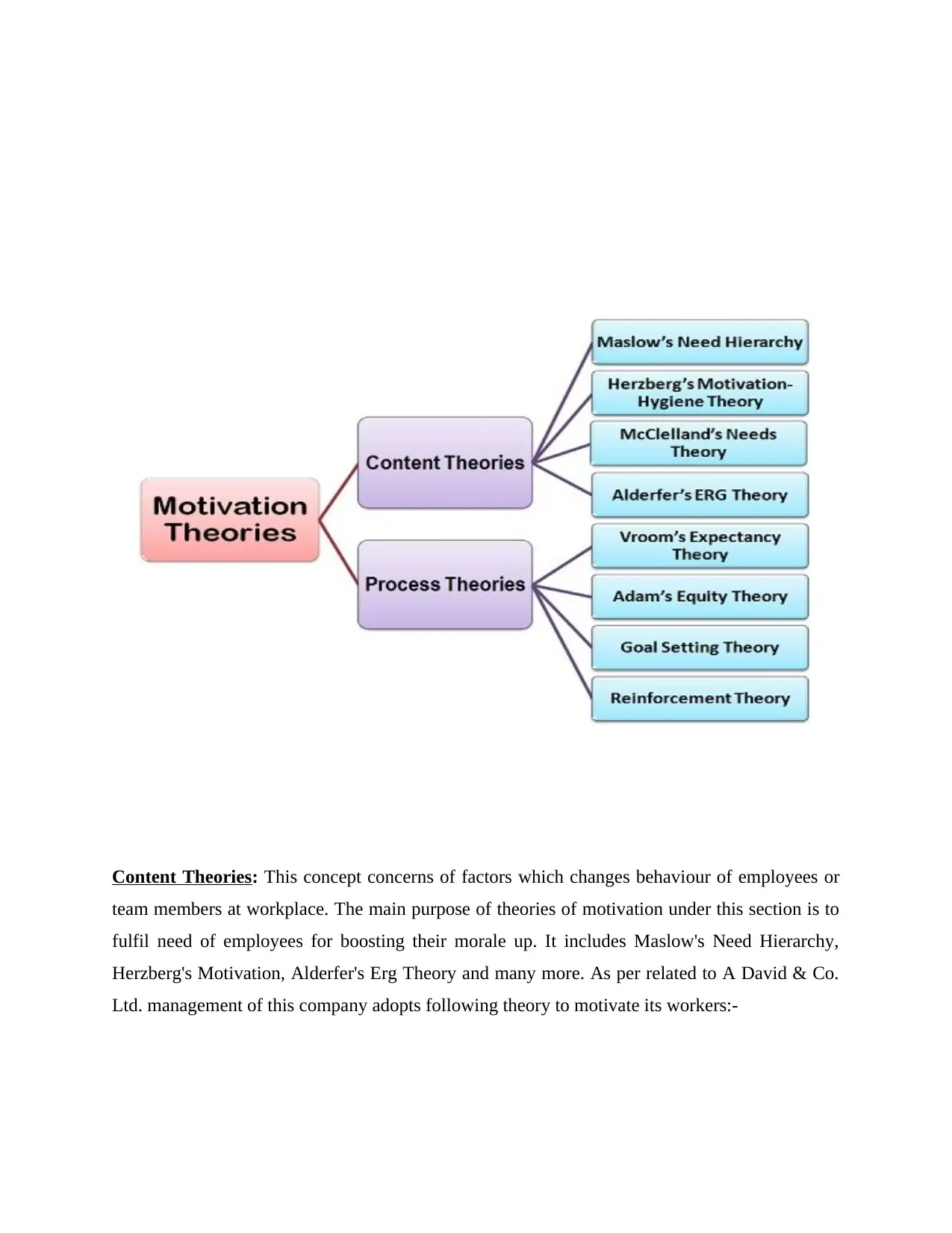
Content Theories: This concept concerns of factors which changes behaviour of employees or
team members at workplace. The main purpose of theories of motivation under this section is to
fulfil need of employees for boosting their morale up. It includes Maslow's Need Hierarchy,
Herzberg's Motivation, Alderfer's Erg Theory and many more. As per related to A David & Co.
Ltd. management of this company adopts following theory to motivate its workers:-
team members at workplace. The main purpose of theories of motivation under this section is to
fulfil need of employees for boosting their morale up. It includes Maslow's Need Hierarchy,
Herzberg's Motivation, Alderfer's Erg Theory and many more. As per related to A David & Co.
Ltd. management of this company adopts following theory to motivate its workers:-
⊘ This is a preview!⊘
Do you want full access?
Subscribe today to unlock all pages.

Trusted by 1+ million students worldwide
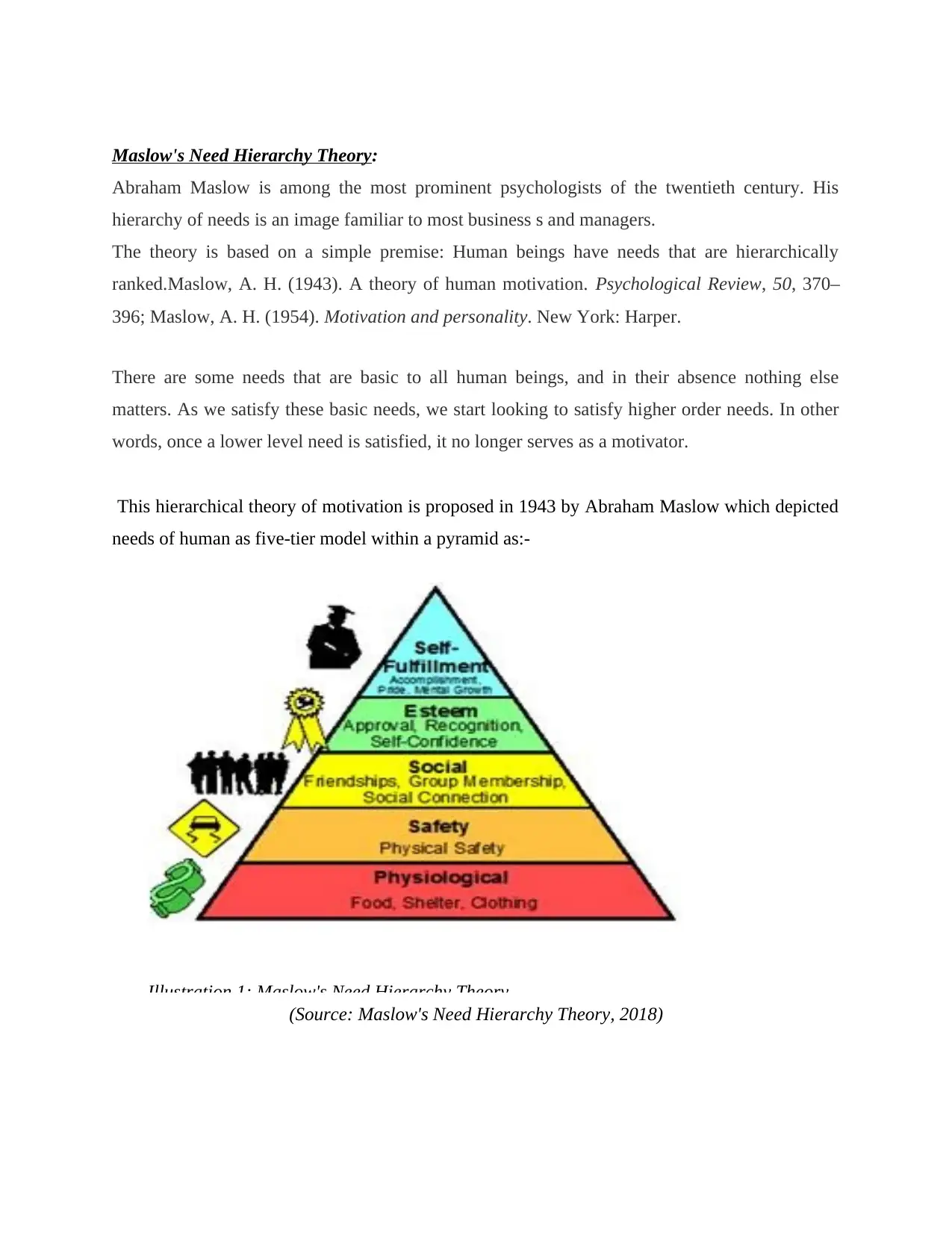
Maslow's Need Hierarchy Theory:
Abraham Maslow is among the most prominent psychologists of the twentieth century. His
hierarchy of needs is an image familiar to most business s and managers.
The theory is based on a simple premise: Human beings have needs that are hierarchically
ranked.Maslow, A. H. (1943). A theory of human motivation. Psychological Review, 50, 370–
396; Maslow, A. H. (1954). Motivation and personality. New York: Harper.
There are some needs that are basic to all human beings, and in their absence nothing else
matters. As we satisfy these basic needs, we start looking to satisfy higher order needs. In other
words, once a lower level need is satisfied, it no longer serves as a motivator.
This hierarchical theory of motivation is proposed in 1943 by Abraham Maslow which depicted
needs of human as five-tier model within a pyramid as:-
(Source: Maslow's Need Hierarchy Theory, 2018)
Illustration 1: Maslow's Need Hierarchy Theory
Abraham Maslow is among the most prominent psychologists of the twentieth century. His
hierarchy of needs is an image familiar to most business s and managers.
The theory is based on a simple premise: Human beings have needs that are hierarchically
ranked.Maslow, A. H. (1943). A theory of human motivation. Psychological Review, 50, 370–
396; Maslow, A. H. (1954). Motivation and personality. New York: Harper.
There are some needs that are basic to all human beings, and in their absence nothing else
matters. As we satisfy these basic needs, we start looking to satisfy higher order needs. In other
words, once a lower level need is satisfied, it no longer serves as a motivator.
This hierarchical theory of motivation is proposed in 1943 by Abraham Maslow which depicted
needs of human as five-tier model within a pyramid as:-
(Source: Maslow's Need Hierarchy Theory, 2018)
Illustration 1: Maslow's Need Hierarchy Theory
Paraphrase This Document
Need a fresh take? Get an instant paraphrase of this document with our AI Paraphraser
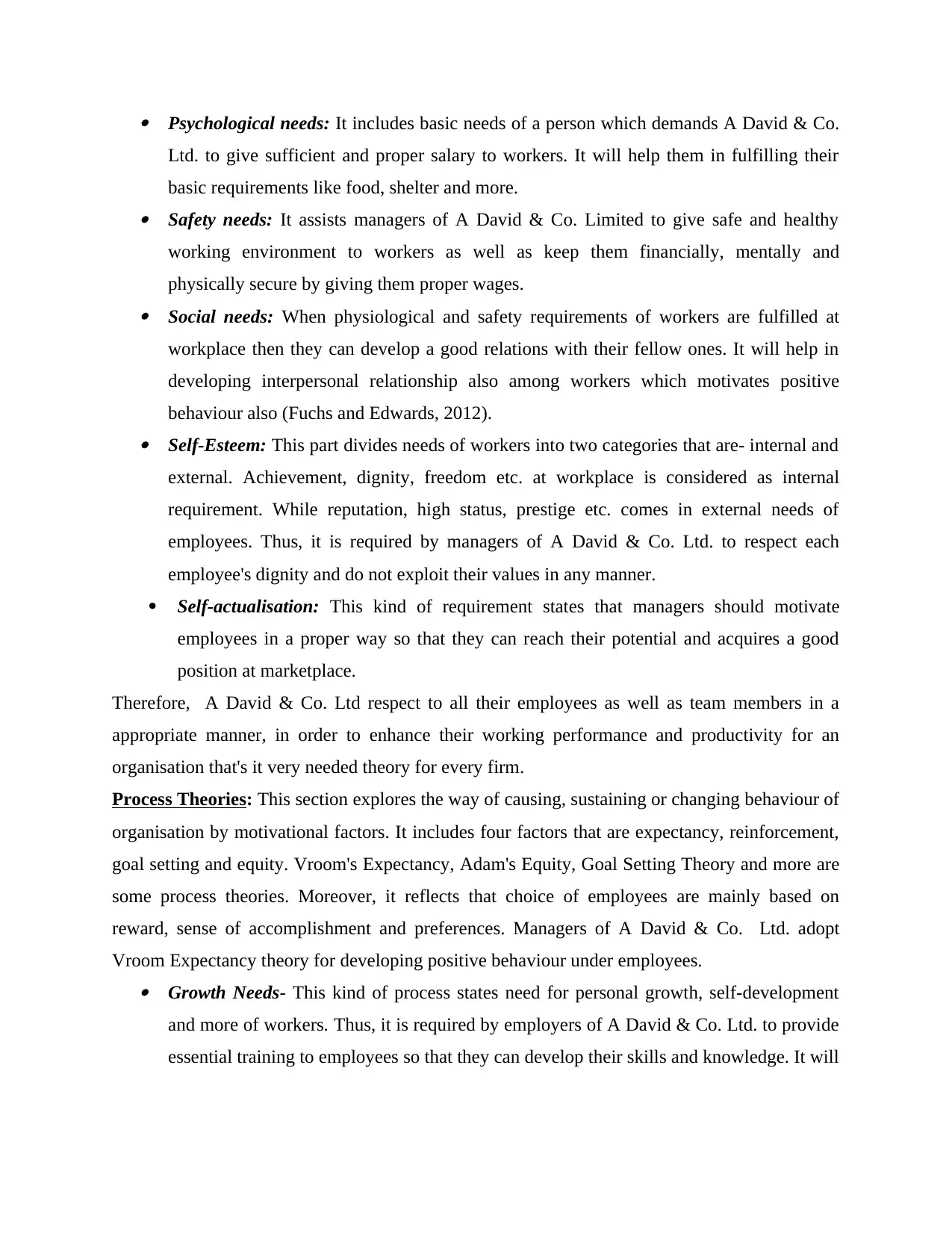
Psychological needs: It includes basic needs of a person which demands A David & Co.
Ltd. to give sufficient and proper salary to workers. It will help them in fulfilling their
basic requirements like food, shelter and more. Safety needs: It assists managers of A David & Co. Limited to give safe and healthy
working environment to workers as well as keep them financially, mentally and
physically secure by giving them proper wages. Social needs: When physiological and safety requirements of workers are fulfilled at
workplace then they can develop a good relations with their fellow ones. It will help in
developing interpersonal relationship also among workers which motivates positive
behaviour also (Fuchs and Edwards, 2012). Self-Esteem: This part divides needs of workers into two categories that are- internal and
external. Achievement, dignity, freedom etc. at workplace is considered as internal
requirement. While reputation, high status, prestige etc. comes in external needs of
employees. Thus, it is required by managers of A David & Co. Ltd. to respect each
employee's dignity and do not exploit their values in any manner.
Self-actualisation: This kind of requirement states that managers should motivate
employees in a proper way so that they can reach their potential and acquires a good
position at marketplace.
Therefore, A David & Co. Ltd respect to all their employees as well as team members in a
appropriate manner, in order to enhance their working performance and productivity for an
organisation that's it very needed theory for every firm.
Process Theories: This section explores the way of causing, sustaining or changing behaviour of
organisation by motivational factors. It includes four factors that are expectancy, reinforcement,
goal setting and equity. Vroom's Expectancy, Adam's Equity, Goal Setting Theory and more are
some process theories. Moreover, it reflects that choice of employees are mainly based on
reward, sense of accomplishment and preferences. Managers of A David & Co. Ltd. adopt
Vroom Expectancy theory for developing positive behaviour under employees. Growth Needs- This kind of process states need for personal growth, self-development
and more of workers. Thus, it is required by employers of A David & Co. Ltd. to provide
essential training to employees so that they can develop their skills and knowledge. It will
Ltd. to give sufficient and proper salary to workers. It will help them in fulfilling their
basic requirements like food, shelter and more. Safety needs: It assists managers of A David & Co. Limited to give safe and healthy
working environment to workers as well as keep them financially, mentally and
physically secure by giving them proper wages. Social needs: When physiological and safety requirements of workers are fulfilled at
workplace then they can develop a good relations with their fellow ones. It will help in
developing interpersonal relationship also among workers which motivates positive
behaviour also (Fuchs and Edwards, 2012). Self-Esteem: This part divides needs of workers into two categories that are- internal and
external. Achievement, dignity, freedom etc. at workplace is considered as internal
requirement. While reputation, high status, prestige etc. comes in external needs of
employees. Thus, it is required by managers of A David & Co. Ltd. to respect each
employee's dignity and do not exploit their values in any manner.
Self-actualisation: This kind of requirement states that managers should motivate
employees in a proper way so that they can reach their potential and acquires a good
position at marketplace.
Therefore, A David & Co. Ltd respect to all their employees as well as team members in a
appropriate manner, in order to enhance their working performance and productivity for an
organisation that's it very needed theory for every firm.
Process Theories: This section explores the way of causing, sustaining or changing behaviour of
organisation by motivational factors. It includes four factors that are expectancy, reinforcement,
goal setting and equity. Vroom's Expectancy, Adam's Equity, Goal Setting Theory and more are
some process theories. Moreover, it reflects that choice of employees are mainly based on
reward, sense of accomplishment and preferences. Managers of A David & Co. Ltd. adopt
Vroom Expectancy theory for developing positive behaviour under employees. Growth Needs- This kind of process states need for personal growth, self-development
and more of workers. Thus, it is required by employers of A David & Co. Ltd. to provide
essential training to employees so that they can develop their skills and knowledge. It will
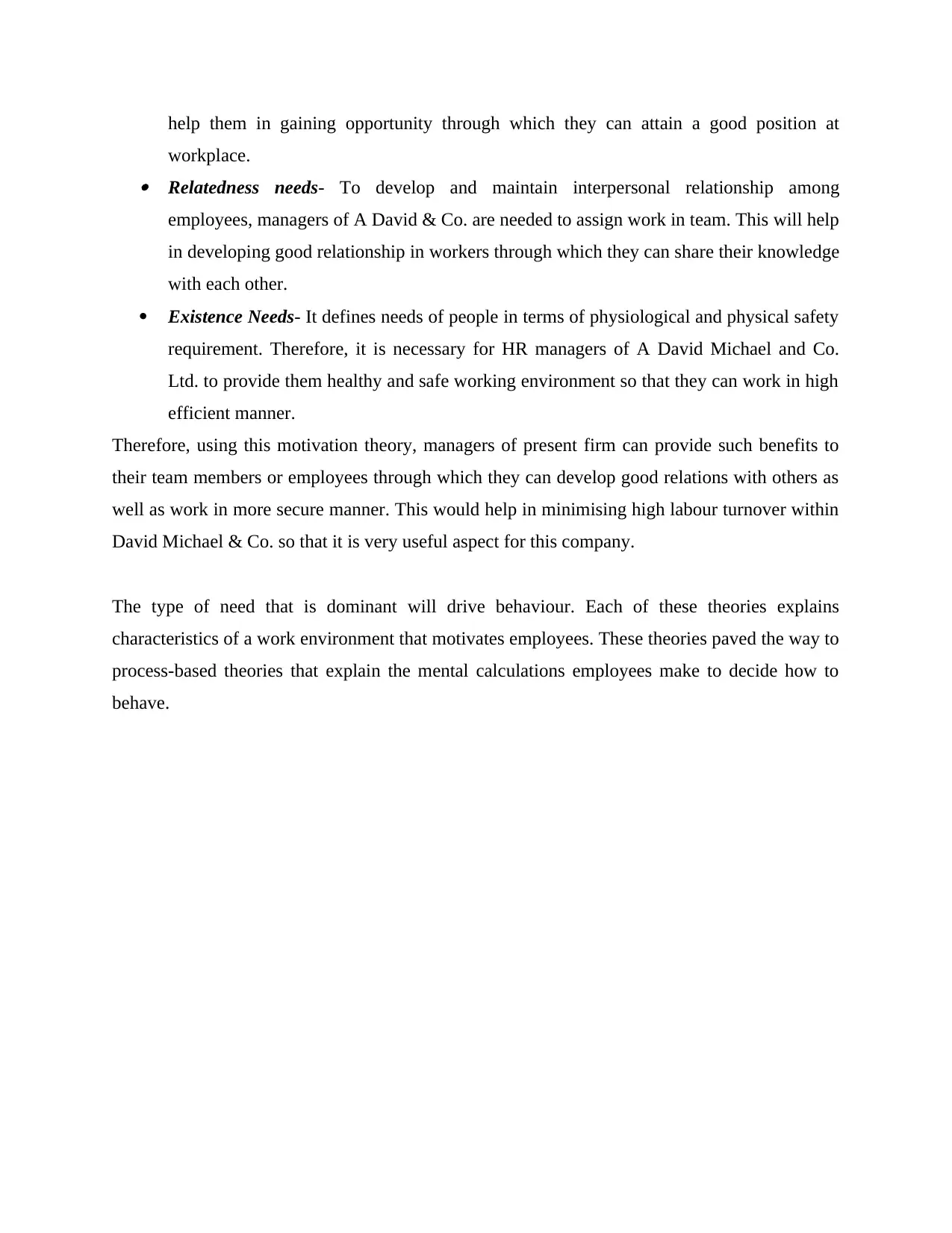
help them in gaining opportunity through which they can attain a good position at
workplace. Relatedness needs- To develop and maintain interpersonal relationship among
employees, managers of A David & Co. are needed to assign work in team. This will help
in developing good relationship in workers through which they can share their knowledge
with each other.
Existence Needs- It defines needs of people in terms of physiological and physical safety
requirement. Therefore, it is necessary for HR managers of A David Michael and Co.
Ltd. to provide them healthy and safe working environment so that they can work in high
efficient manner.
Therefore, using this motivation theory, managers of present firm can provide such benefits to
their team members or employees through which they can develop good relations with others as
well as work in more secure manner. This would help in minimising high labour turnover within
David Michael & Co. so that it is very useful aspect for this company.
The type of need that is dominant will drive behaviour. Each of these theories explains
characteristics of a work environment that motivates employees. These theories paved the way to
process-based theories that explain the mental calculations employees make to decide how to
behave.
workplace. Relatedness needs- To develop and maintain interpersonal relationship among
employees, managers of A David & Co. are needed to assign work in team. This will help
in developing good relationship in workers through which they can share their knowledge
with each other.
Existence Needs- It defines needs of people in terms of physiological and physical safety
requirement. Therefore, it is necessary for HR managers of A David Michael and Co.
Ltd. to provide them healthy and safe working environment so that they can work in high
efficient manner.
Therefore, using this motivation theory, managers of present firm can provide such benefits to
their team members or employees through which they can develop good relations with others as
well as work in more secure manner. This would help in minimising high labour turnover within
David Michael & Co. so that it is very useful aspect for this company.
The type of need that is dominant will drive behaviour. Each of these theories explains
characteristics of a work environment that motivates employees. These theories paved the way to
process-based theories that explain the mental calculations employees make to decide how to
behave.
⊘ This is a preview!⊘
Do you want full access?
Subscribe today to unlock all pages.

Trusted by 1+ million students worldwide
1 out of 24
Related Documents
Your All-in-One AI-Powered Toolkit for Academic Success.
+13062052269
info@desklib.com
Available 24*7 on WhatsApp / Email
![[object Object]](/_next/static/media/star-bottom.7253800d.svg)
Unlock your academic potential
Copyright © 2020–2025 A2Z Services. All Rights Reserved. Developed and managed by ZUCOL.





